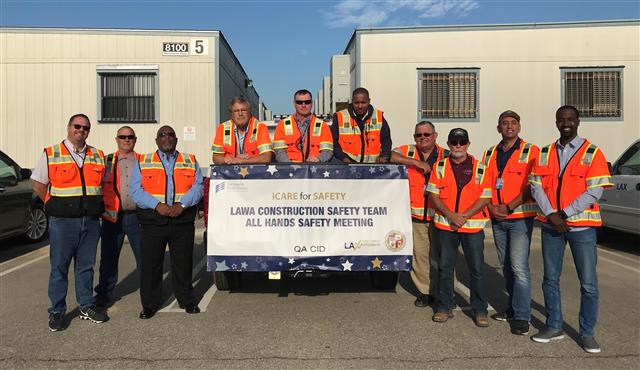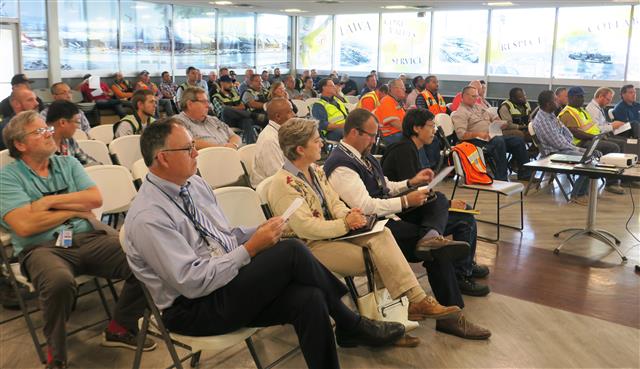
For Immediate Release
Sept. 10, 2019
Contact:
LAX Public Relations
(424) 646-5260

(Los Angeles, CA) The $14.3 billion modernization at Los Angeles International Airport (LAX) was already the largest public works program in the history of Los Angeles, and now it’s also one of the safest, with no lost-time incidents over the last year of construction work at the airport.
Between January and June, construction workers recorded a total of 2,834,554 hours without a lost-time injury. Meanwhile, workers on the Automated People Mover project recently passed 1 million hours worked without a lost-time injury.
"Safety is at the core of everything we do at Los Angeles World Airports, and as we lead the nation in modernizing our facilities it’s more critical than ever that we hold ourselves and our contracting partners to the highest standards to protect our passengers and employees,” said Deborah Flint, Chief Executive Officer, LAWA. “As of August, we have more than 2,500 women and men working on construction projects at LAX, and our exceptional safety record shows their dedication to building the future of this airport in the safest ways possible.”
Over the past five years, Los Angeles World Airports (LAWA) has performed exceptionally well on two industry-recognized benchmarks. LAWA’s Lost Time Incident Rate of 0.14 and Total Recordable Incident Rate of 1.07 exceed LAWA’s ambitious goal of one-third of the national average (1.3 and 3.5) for these key rates. The OSHA Lost Time Case Rate is calculated by multiplying the number of recordable cases that contained lost work days by 200,000, and then dividing that number by the number of labor hours at the company. The Recordable Incident Rate is a similar calculation, only it uses all incident cases, not just those with lost work days.
Leading this success is a team of assistant safety managers supported by a robust group of construction inspectors who enforce safety and security within active construction zones, in addition to ensuring compliance with construction quality requirements.
LAWA’s Construction Safety Program sets additional standards that go over and above those established by the California Division of Occupational Safety and Health and the contractors' site-specific Injury and Illness Prevention Program (IIPP), which is a proactive plan to find and fix potential hazards before workers are hurt.
These requirements were developed by LAWA to promote safety and minimize the hazards and risks associated with construction projects. This policy is designed to minimize, with a goal of eliminating, personal injuries and property damage associated with construction activities.
The effectiveness of the construction safety program depends upon the active participation of the contractor and recognizes dependency on active participation and cooperation of contractors’ staff in carrying out basic procedures, including:
- Planning safety into all work activities to minimize the potential for personal injury, property damage, and loss of productive time.
- Complying with federal, state and local laws, ordinances, and regulations; industry standards; and airport regulations and requirements.
- Maintaining a system of prompt detection and correction of unsafe practices and conditions.
- Establishing and conducting an educational program to stimulate and maintain interest and cooperation of all employees through safety meetings and safety training programs, through the use of personal protective equipment and mechanical guards, and through prompt notification and investigation of all accidents, incidents or claims to determine the causes and to take necessary corrective action.
Contractors working on LAWA projects are required to send representatives to a monthly all-hands meeting. The informative, hour-long meeting is led by the LAWA Program Safety Manager. A typical agenda includes discussion of any incidents and lessons learned, updates on the construction and safety programs, and access to representatives of different equipment vendors or utility companies who can talk about new safety features and best practices. A representative of the Occupational Safety and Health Administration (OSHA) Training Center at California State University Dominguez Hills is on hand bimonthly to provide no-cost training.
Since 2014, LAWA has maintained an online safety training program where members from the LAWA project management teams, project managers, construction managers, and construction inspectors are required to participate in a monthly online safety training and quiz. LAWA provides a 10-hour OSHA training class for contractors and airport staff each month. LAWA’s safety staff hold professionally recognized Certified Health & Safety Technician (CHST) certification or higher from the Board of Certified Safety Professionals. LAWA also has a training program for construction inspectors who start at the Assistant Inspector position, a trainee level classification, and over the course of 2.5 years become qualified for full duties.

LAX, the fourth-busiest airport in the world and second busiest in the United States, was named a top-10 U.S. airport by SKYTRAX. LAX served more than 87.5 million passengers in 2018 and offers an average of 700 daily nonstop flights to 109 cities in the U.S. and 1,281 weekly nonstop flights to 93 markets in 47 countries on 69 commercial airlines. LAX ranks 10th in the world in air cargo tonnage processed, with more than 2.4 million tons of air cargo. LAX handled 707,883 operations (landings and takeoffs) in 2018.
LAX generated 620,600 jobs in Southern California, with labor income of $37.3 billion and economic output (business revenues) of more than $126.6 billion, according to an economic study based on 2014 operations. This activity added $6.2 billion to local and state revenues and $8.7 billion in federal tax revenues. The study also reported that LAX’s ongoing capital improvement program creates an additional 121,640 annual jobs with labor income of $7.6 billion and economic output of $20.3 billion; $966 million in state and local taxes; and $1.6 billion in federal tax revenues.
LAX was honored as having the “Best Overall Customer Service Program” by Airports Council International-North America; named the “Best Airport for Breastfeeding Moms” by Mamava; selected for the Top 10 “Best of the U.S.’s Big Airports” (Wall Street Journal) and “Most Pet-Friendly Airports in the U.S. (Mental Floss); named the second-most improved airport in the U.S. by JD Power; received an “Innovation Award” from the L.A. Better Business Challenge for its Central Utility Plant; and named a “Business Leader in Air Quality” by the South Coast Air Quality Management District.
LAX is also the second-most popular airport in the world to appear on Instagram, according to wego.com. LAX is part of a system of two Southern California airports – along with Van Nuys general aviation – that are owned and operated by Los Angeles World Airports, a proprietary department of the City of Los Angeles that receives no funding from the City’s general fund.
As a covered entity under Title II of the Americans with Disabilities Act, the City of Los Angeles does not discriminate on the basis of disability and, upon request, will provide reasonable accommodation to ensure equal access to its programs, services, and activities. Alternative formats in large print, braille, audio, and other forms (if possible) will be provided upon request.
